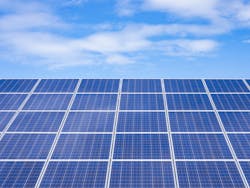Puerto Rico Bill Would Seek 100 Percent Renewable Energy & Streamline Interconnection
A special legislative commission in Puerto Rico is considering a bill that would put the US territory on track to meet its electric demand with 100 percent renewable energy by 2050, as well as streamline grid interconnection of distributed energy and microgrids.
The proposed “Public Policy Law on Energy Diversification through Sustainable and Alternative Renewable Energy in Puerto Rico” also moves the ball on several other clean energy initiatives.
In addition to seeking 100 percent renewable energy, the bill would eliminate coal-fired generation by 2028. It would launch a study by Puerto Rico’s Energy Bureau to set goals for energy storage. And retail energy providers would gain the ability to purchase any type of renewable energy certificates, including those created by homes and businesses using net metering.
The bill is the latest initiative by Puerto Rico’s government in response to the devastation wrought by Hurricane Maria last year, as well as resolve longstanding price and reliability issues regarding bankrupt, state-owned utility Puerto Rico Electric Power Authority (PREPA).
Central urgency in Puerto Rico
Meanwhile, Puerto Ricans are moving ahead of politics and government when it comes to their energy future. A growing number of homeowners, public services agencies and non-governmental organizations, communities and businesses are investing in solar photovoltaic (PV) and battery-based energy storage systems, as well as minigrids and microgrids.
“There’s a central sense of urgency developing that we need to be independent of the centralized grid, and industry players and Puerto Ricans are moving ahead and doing that,” said San Juan resident and Sunnova General Manager Karla Zambrana Meléndez. Sunnova is the leading residential solar energy and battery energy storage systems installation and finance company on the island.
The bill’s authors say that the proposed Public Energy Policy Law of Puerto Rico (for short) would guide creation of an energy system that’s resilient, reliable and robust, with fair and reasonable tariffs for all classes of consumers. If enacted, it would also help consumers generate their own energy and facilitate interconnection to distributed generation and microgrids.
Furthermore, it would modify the 1941 Puerto Rico Electricity Power Authority (PREPA) Law to restructure the Government Board of the Electric Power Authority so as to align the regulatory body’s policies and decision-making with the bill’s aims and goals.
A 180-degree shift
Puerto Ricans’ lives, and their views and actions regarding energy, turned 180 degrees in the wake of Hurricane Maria, according to Zambrana Meléndez. Customers, by and large, wanted grid-connected PV systems before Hurricane Maria. Since then, Sunnova has been installing solar-plus-storage systems exclusively.
“Customers are willing to pay for resiliency, and they’re asking for solar-plus-storage,” Zambrana Meléndez said.
The company, along with its business partners and industry peers, has been lobbying government to ensure that solar, energy storage and distributed energy play a central role in the national energy strategy the government is expected to present to the public by year-end, she said.
Fine for interconnection delays
One key aspect of the proposed renewable energy bill is that it would ensure that the interconnection process isn’t unnecessarily long or onerous for consumers. It would limit the interconnection of “non-exporting systems” (those that don’t send electricity back on to the grid) to simply notifiying the utility. In addition, it would limit the time the utility takes to interconnect behind-the-meter, solar-plus-storage systems that do export electricity to the grid to 90 days. Failure to do so would result in a fine of $1,000 per day per system, according to Meghan Nutting, executive vice president, policy and communications for Sunnova.
“Very few bills in the past have included enforcement mechanisms. This bill goes further than any other by including penalties for not meeting deadlines, Nutting said.
But Nutting added the bill could go further. “It’s still important PREPA is overseen by a strong, bipartisan, independent regulator, and the legislation could include more language to assure that.”
Looking ahead, members of the special commission on energy need to pass the bill in order for it to be presented and voted on by Puerto Rico’s House of Representatives and Senate. It would then move on to Governor Ricard Roselló.
Sunnova expects the bill will pass into law, and before year-end, when the government is due to present its new energy market and regulatory strategy, according to Zambrana Meléndez.
If the bill becomes law, Puerto Rico would join a growing worldwide movement by cities, states and countries to pursue 100 percent renewable energy or similar clean energy goals. For example, California Gov. Jerry Brown last month signed into law a mandate that the state achieve 100 percent zero-carbon electricity by 2045. Separately, California also enacted a law to streamline microgrid interconnection and make other changes to encourage microgrid development.
Track news about the 100 percent renewable energy movement. Subscribe to the free Microgrid Knowledge newsletter.
